Introduction
Adopting an MVP strategy in software development can be a game-changer. It allows you to focus on the core features that address the crucial needs of your users, accelerating the delivery of value while reducing costs and risks. In just 12 to 16 weeks, you can go from concept to market-ready product.
But before diving into the details, it's important to consider the suitability of this approach for your business. In this article, we will explore the concept of MVP, its key stages of development, the importance of market research and user feedback, and the iterative development process. By the end, you'll have a solid understanding of how an MVP can transform your product and guide your business towards success.
Understanding the Concept of MVP
Adopting an MVP strategy is quintessential for swiftly navigating the complex landscape of software development. The crux of an MVP approach is to hone in on the core features that address the pivotal needs of your users.
This methodology not only accelerates the delivery of value but also significantly trims down development costs and diminishes risks. With an MVP, you can typically transition from concept to market-ready product within a span of 12 to 16 weeks, as opposed to the protracted timeline of six months to two years that traditional product development may entail.
Crafting an engrossing user story is paramount. It is through this narrative that potential customers will grasp the utility of your product and envision its role in their lives.
A tangible demonstration of the product's functionality can be a compelling touchpoint, cementing the value proposition in the minds of your stakeholders and investors. While an MVP can be a cost-effective and expedient route to market, it's imperative to consider the suitability of this model for your business.
Leveraging established tools can expedite the development process, allowing you to concentrate on the unique aspects of your product. However, if the MVP is merely a stopgap that cannot be evolved into the final product, the strategy may prove counterproductive. This caveat is particularly pertinent for businesses with constrained resources or those lacking in technical expertise, where the MVP must be carefully calibrated to serve as a foundation for future development. The narrative of Amazon's evolution from a modest online bookstore to a behemoth in various industries, and Airbnb's origins from a simple room-letting concept, underscore the transformative potential of a well-executed MVP. These anecdotes highlight the importance of validating your product concept with real users and the agility an MVP affords in steering your business towards uncharted territories.
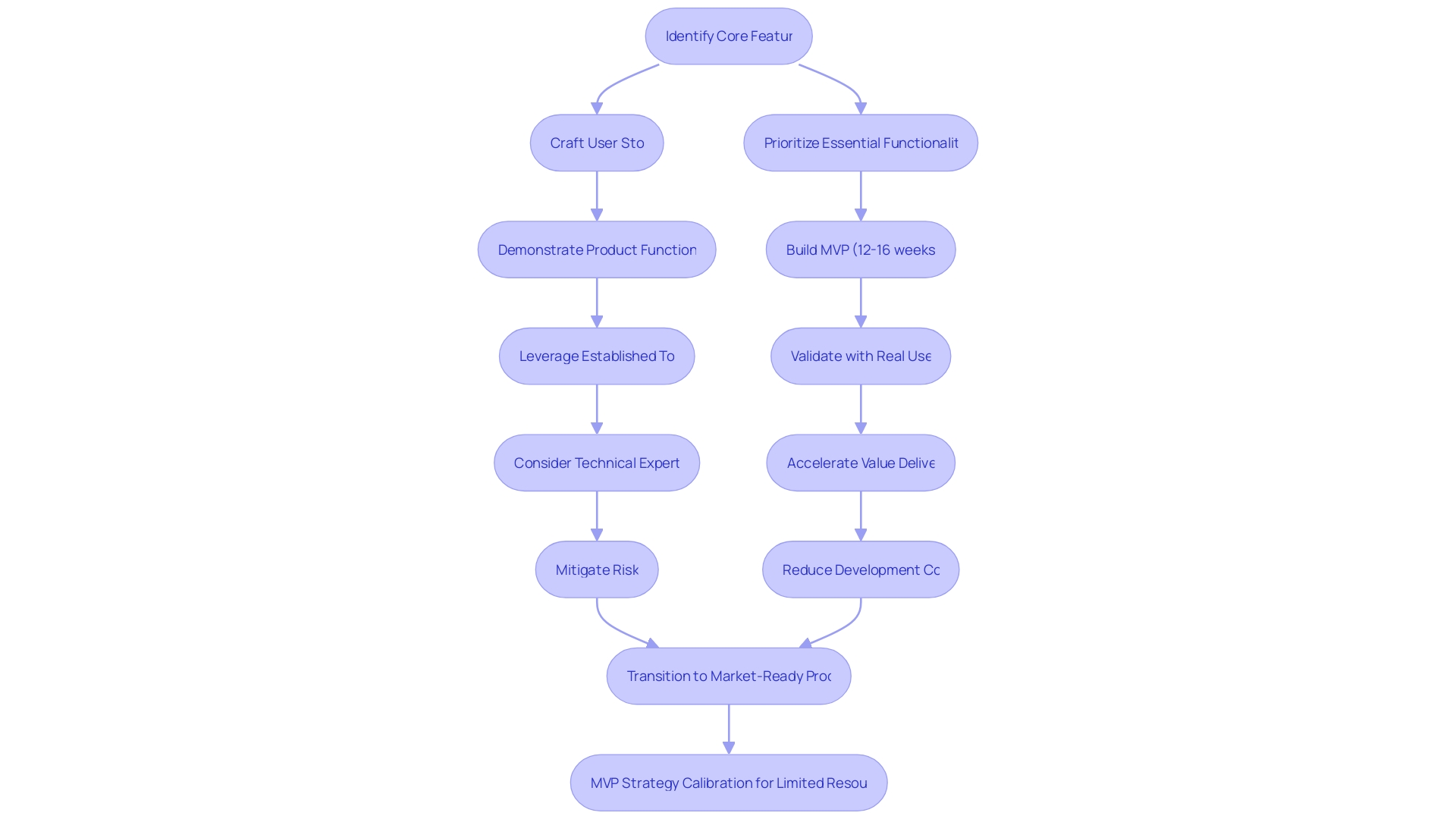
Key Stages of MVP Development
The creation of a Minimum Viable Product (MVP) is a strategic process that typically unfolds over 12 to 16 weeks, depending on the project's complexity and scope. It begins with ideation, where the core concept is fleshed out, followed by meticulous market research to ensure alignment with customer needs.
Defining the MVP scope is the next critical step, which involves identifying the essential features that will deliver value to early adopters. Prototyping then brings the idea to life, offering a tangible experience that can be tested and refined.
It's during this phase that an engaging user story becomes pivotal, illustrating how the product will solve real problems for customers. Once the prototype is ready, testing is conducted to gather user feedback, which is instrumental in the iterative development process. This approach not only saves significant time—potentially shortening the product development cycle from years to mere weeks—but also arms you with vital metrics that can bolster confidence in your product's market fit and growth trajectory. Indeed, a well-executed MVP is more than just a product; it's a research tool that informs your strategy and paves the way for sustained success.
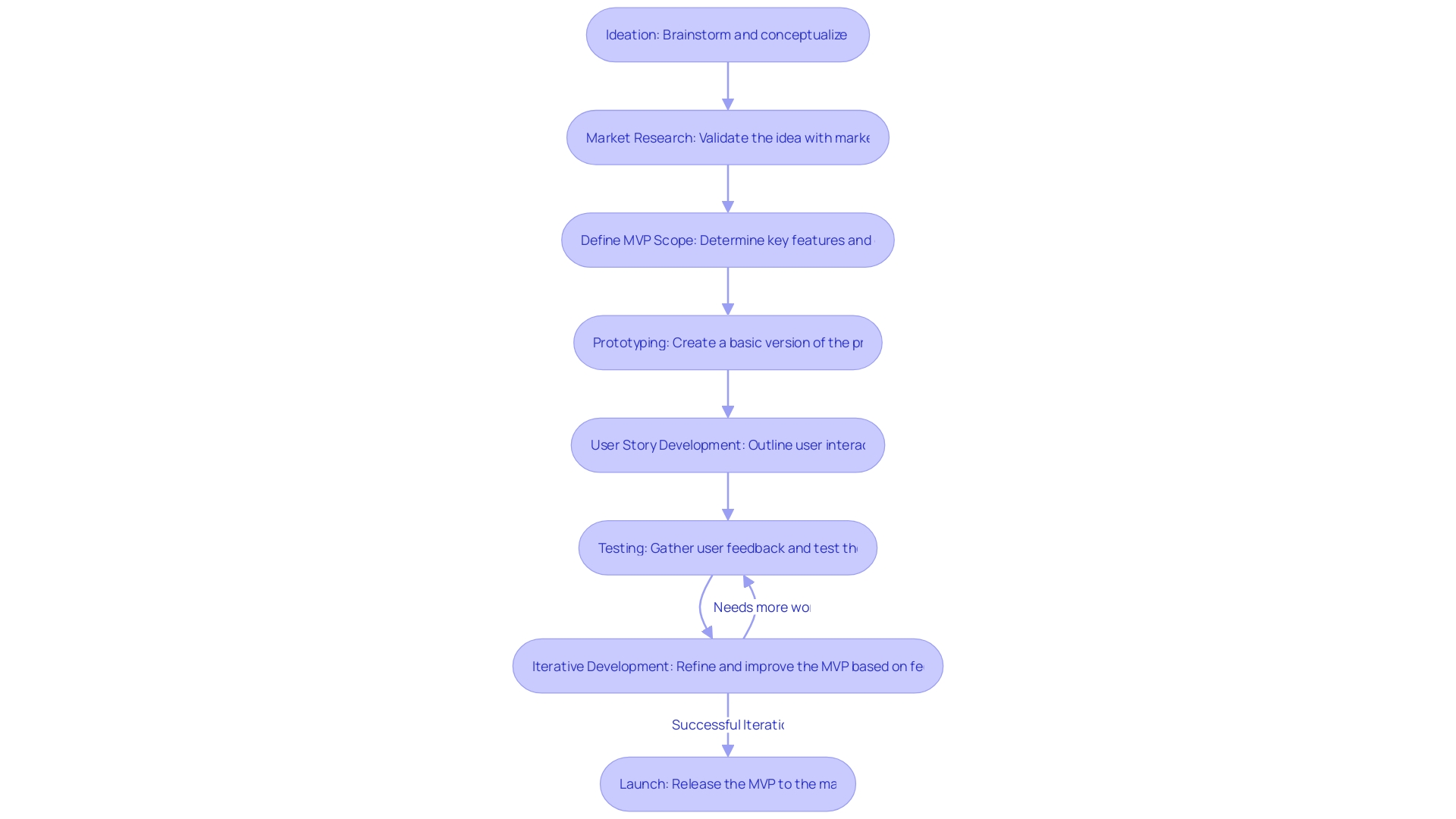
Market Research and User Feedback
When embarking on MVP software development, a meticulously crafted user story can be your North Star. It's not just about the features; it's about how your product tangibly benefits the customer. With an MVP, you've done the groundwork, and it's time to showcase the fruits of your labor.
A compelling demonstration of your product's functionality not only captivates your audience but also conveys the depth of your market research. Imagine giving your investors a vivid picture of the data you've collected, the analysis undertaken, and the user challenges you're aiming to solve. This approach not only affirms the existence of a problem but positions your product as the solution.
Custom software projects can be a quagmire of time and resources without a clear-cut strategy. An MVP, however, is a strategic compass, offering a streamlined version of your software that zeroes in on core features to address your target audience's most pressing needs. It's a prototype that delivers value and sets the stage for further development based on user feedback and market demand.
Consider the story of Appinventiv, an MVP development company that's propelled brands like KFC and Ikea to new heights through its Lean Startup Methodology. They validate product ideas, gather user insights, and iterate rapidly, embodying the essence of MVP development. As you hone your MVP, remember that it must resonate with each user subgroup.
Employing a human-centered design approach and journey mapping ensures that your MVP meets the nuanced needs of all your users. A diverse business analysis team is crucial for translating user insights into concrete requirements. With these strategies, you can forge an MVP that's not just a product but a beacon guiding your business forward.
Defining the MVP and Prioritizing Features
Crafting a Minimum Viable Product (MVP) is a strategic endeavor that centers on constructing a basic yet functional version of software tailored to solve the most critical problems faced by your target audience. The essence of an MVP lies in its focus on pivotal functionalities that deliver the core value proposition to end-users, ensuring that the initial prototype is a true representation of what the final product aspires to be.
This approach is instrumental in mitigating risks and enhancing the probability of success by enabling early and frequent customer feedback, which serves to validate the business concept and refine the product. A practical MVP development cycle ranges from 12 to 16 weeks, demanding a clear understanding of the project's idea, scope, and complexity.
It is during this time that an MVP, by embodying the minimum yet viable features, becomes a litmus test for market fit, allowing insights into user acceptance and demand. In the realm of MVP development, iteration is key.
It involves coding, even if imperfect, to learn from the challenges that arise, thereby reinforcing the product with each cycle. Leveraging established tools and existing technologies can be advantageous, particularly when resources are scarce or when specialized technical know-how is not within immediate reach.
This pragmatic approach facilitates a focus on the unique selling points of the product while still enabling real user validation of the concept. However, it's vital to consider the trade-offs of this method, as it may not suit every business model, especially if it leads to a complete rebuild post-MVP launch. Ultimately, the performance of your MVP in the market, illustrated through hands-on product demos and compelling user stories, becomes a powerful negotiating tool. It not only demonstrates the product's problem-solving capabilities but also instills confidence in its market viability. It's a strategic compass that guides the journey from a nascent idea to a successful product that resonates with users and thrives in the market.
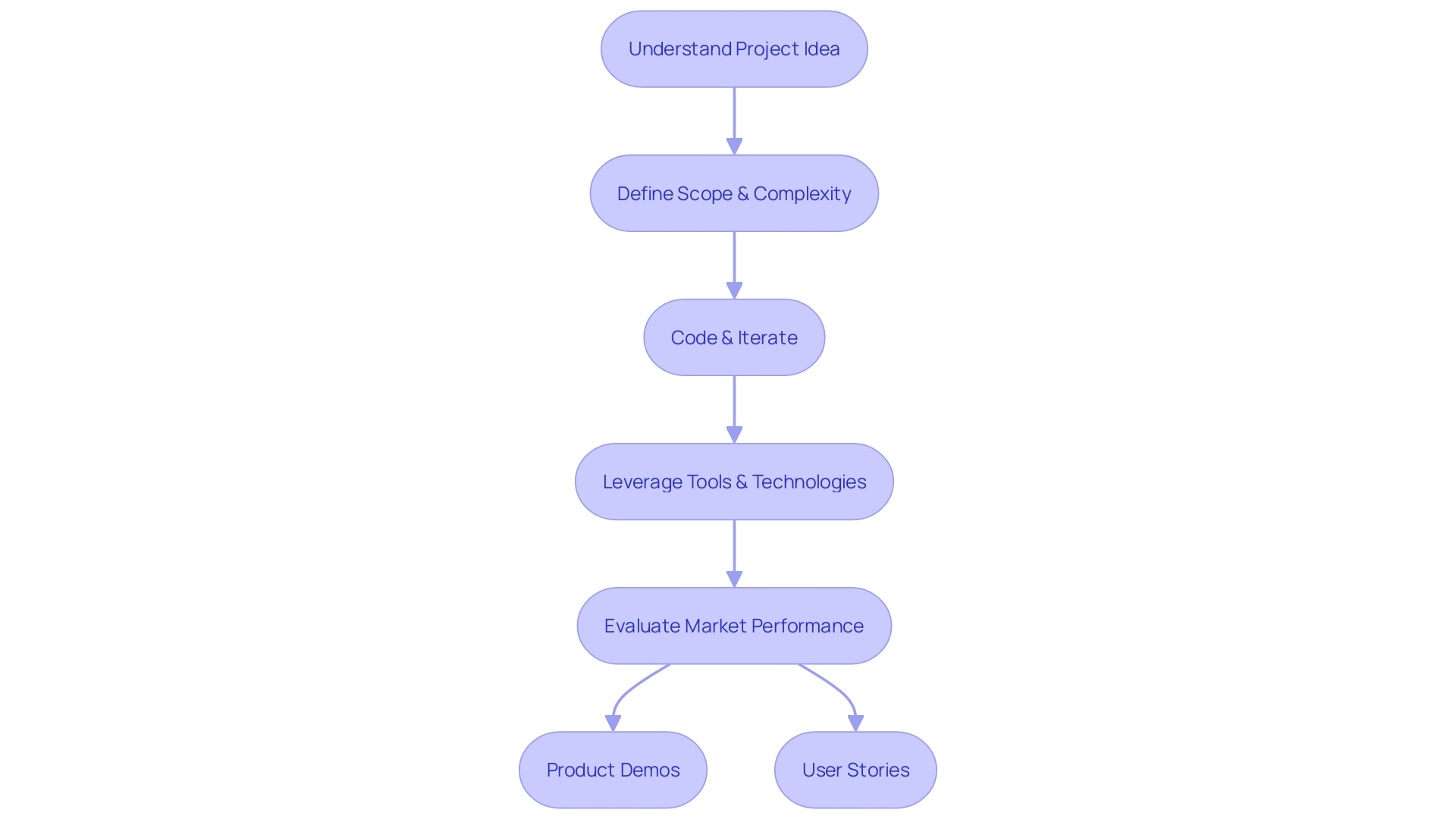
Prototyping and Testing
MVP software development is akin to the work of an architect not in laying the final brick but in crafting a scale model to visualize the end goal. It's about shaping a prototype that embodies the core functionalities and user experience of the envisioned product.
This prototype acts as a tangible reference for stakeholders, enabling the collection of valuable feedback that refines the product vision. The prototyping phase is a strategic investment, allowing developers to iterate rapidly and integrate essential features with precision, thus embodying the concept that 'less is more.'
As Jared Spool insightfully puts it, this process often leads to discoveries about the problem that were previously obscured. Testing, a complementary and equally vital step, focuses on quality assurance.
It's about uncovering and addressing bugs or usability issues that could undermine the user experience. The aim is to mitigate risks and validate the product with real users, ensuring the technology not only functions but flourishes in the intended market. This adherence to user-centric development is underscored by the fact that an MVP can be developed in a timeframe of 12 to 16 weeks, a stark contrast to the potential years of traditional product development. It's a process that not only accelerates time-to-market but also fosters a hands-on understanding of the user's needs, culminating in a product narrative that resonates with customers and investors alike.
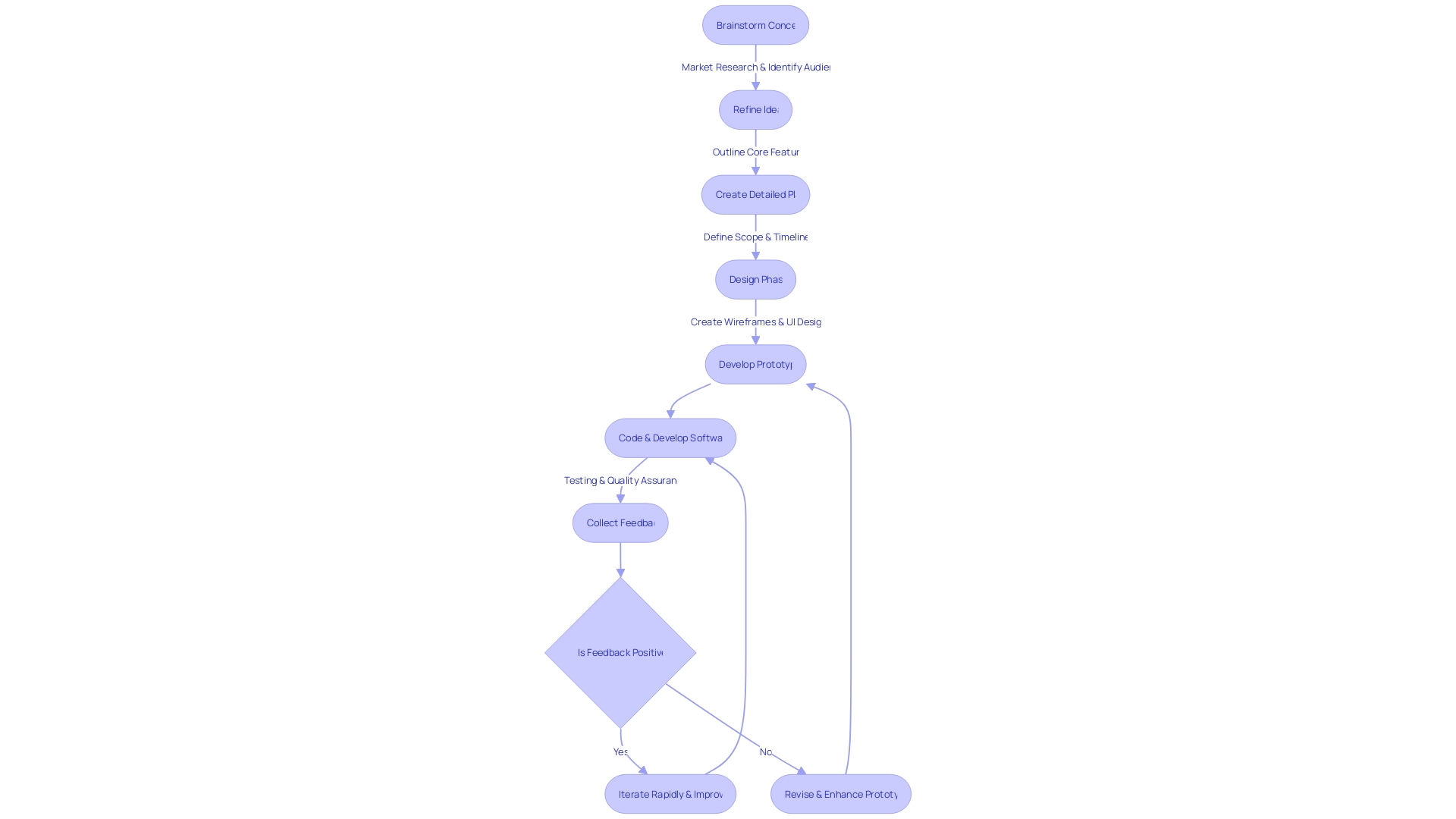
Iterative Development and Feedback Loop
MVP software development is a strategic approach that emphasizes the value of launching a core-feature product to early users. This practice allows businesses to align their software solutions closely with user feedback and market demands, ensuring that the product evolves to meet real-world needs.
By constructing an MVP, companies can avoid the pitfalls of over-engineering and instead focus on a targeted feature set that delivers genuine value. The process is not just about speed to market, but about creating a user story that resonates, as a compelling narrative can significantly impact customer engagement.
The MVP phase typically ranges from 12 to 16 weeks, during which the idea, scope, and complexity of the technology are rigorously defined. It's a period of intense learning and research, culminating in a hands-on demonstration that showcases the product's functionality and potential impact.
Agile methodology enhances this process by promoting frequent builds, testing, and reviews, which helps in swiftly addressing defects and managing project challenges such as cost, schedule, and scope. This iterative cycle of build-measure-learn is crucial for startups to maintain momentum, gain insights, and make data-driven adjustments. In selecting a custom software development partner, it's important to consider their expertise, experience, and ability to adapt project management methodologies to fit the unique aspects of the product. Leveraging established tools can mitigate the risk of technical debt and enable teams with limited resources or technical expertise to participate in the MVP process. Ultimately, the goal is to refine the product through continuous iteration, informed by a feedback loop that connects the development team with the end-users' experiences and expectations.
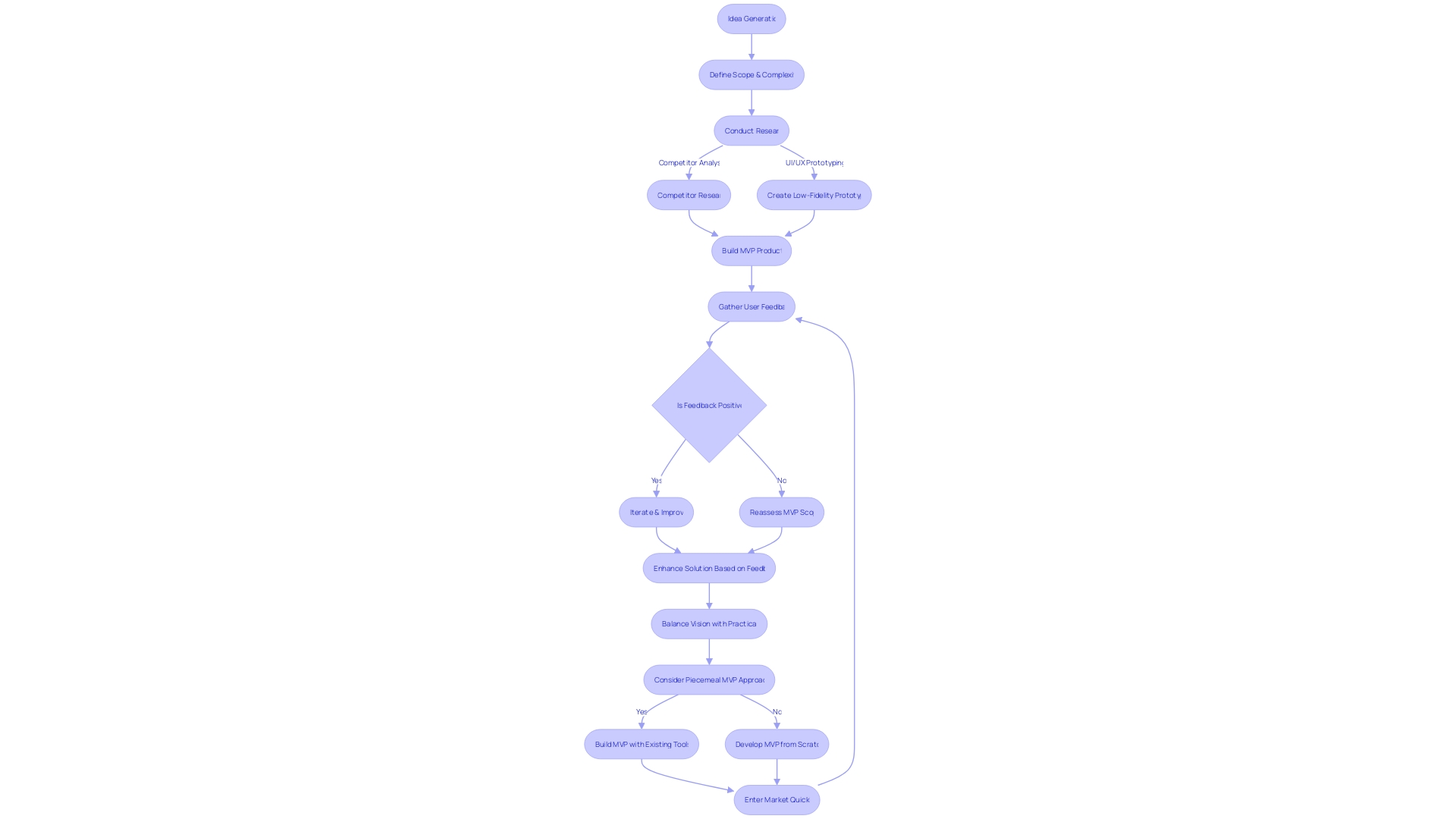
Conclusion
In conclusion, adopting an MVP strategy in software development allows businesses to focus on core features, accelerate value delivery, and reduce costs and risks. With an MVP, businesses can go from concept to market-ready product in just 12 to 16 weeks.
Key stages of MVP development include ideation, market research, defining the scope, prototyping, testing, and iterative development. These stages ensure alignment with customer needs and gather valuable user feedback for refinement.
Market research and user feedback are crucial in MVP software development. Validating product concepts with real users and iterating based on their insights are essential for success.
Employing a human-centered design approach ensures the MVP meets all users' needs. Defining the MVP and prioritizing features is critical.
Crafting a functional version that solves key problems for the target audience is key. Leveraging established tools and technologies can be advantageous when resources or technical expertise is limited.
Prototyping and testing are strategic investments. Prototypes provide a tangible experience for feedback collection, while testing ensures quality assurance and validates the product in the intended market. Iterative development and a feedback loop align software solutions with user feedback and market demands. Launching a core-feature product to early users creates a compelling narrative that resonates with customers. In summary, adopting an MVP strategy enables businesses to deliver value quickly while mitigating risks. It empowers them to focus on essential features, validate concepts with real users, iterate rapidly based on feedback, and create products that resonate with customers. By following these principles, businesses can guide their journey towards success in today's competitive landscape.





